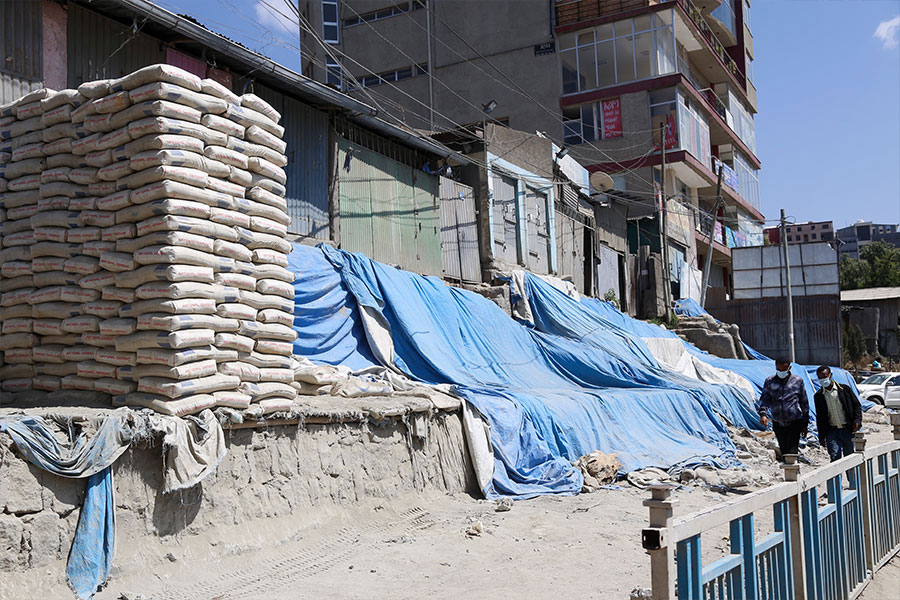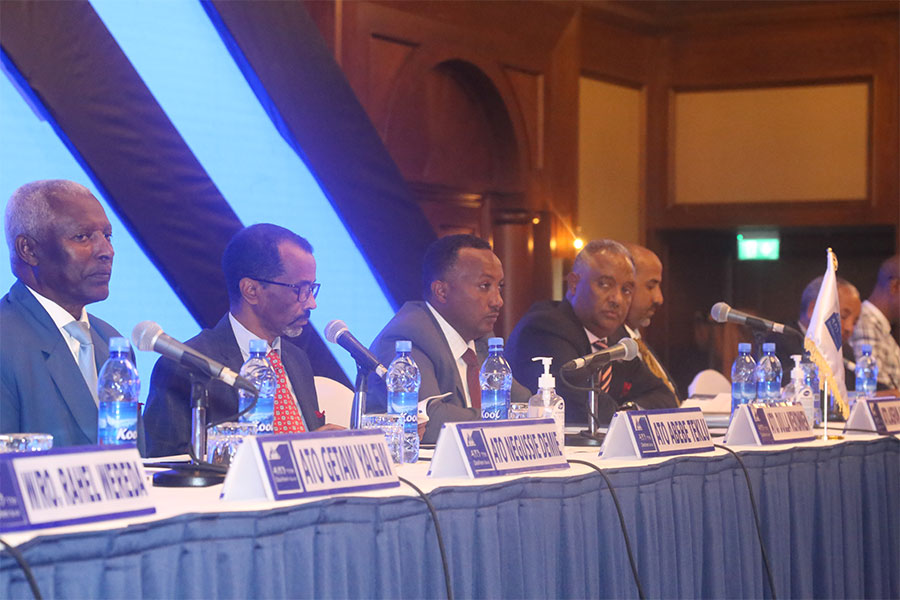
Commentaries | Oct 16,2024
On the outskirts of Addis Abeba lies the subdued Qaliti cement market with retailers like Tsigereda Eshetu gazing for customers that may be interested in their products. The price for a quintal of cement has sharply dropped by 27pc to 1,700 Br.
Over the past two weeks, demand has remained neutral. Tsigereda, who sources her stock from Dangote and Habesha factories, hopes for a turnaround.
“Buyers will come,” she said. "Perhaps when the market stabilises further."
For Yigerem Tewodros, another retailer, the issue lies deeper. He blames the outsized role of middlemen and brokers in inflating prices and disrupting the market, calling for structural changes to alleviate traders’ woes.
“We need direct access to manufacturers,” he told Fortune.
The cement industry is changing, spurred by recent government reforms. These include granting manufacturers autonomy in setting distribution prices, a shift designed to address inefficiencies and stabilise the market. However, difficulties such as power outages, security concerns, and low-quality coal continue to plague the industry.
The Ministry of Trade & Regional Integration (MoTRI) has introduced measures to liberalise the market, notably removing restrictions on manufacturers' gate prices. Minister Kassahun Goffe (PhD) recently noted the need to boost production capacity. Ethiopia’s annual cement production stagnates at seven million tons, far short of the 36 million tons demanded by the booming construction industry. Kassahun urged manufacturers to achieve 80pc operational capacity, which could yield up to 20 million tons annually.
Lemi National Cement—inaugurated by Prime Minister Abiy Ahmed (PhD) two months ago—is anticipated to play a major role. With a daily production capacity of 150,000qtl, the plant represents a potential game-changer for a market beset by shortages. East African Holding, a major shareholder, has already begun distributing cement, stabilising prices and boosting supply.
Industry veteran Mesfin Abi, a founding CEO and current board member of Habesha Cement, supports the move. He criticises past government price controls, arguing that they exacerbated shortages and favoured intermediaries. Mesfin sees the reforms as a step toward aligning supply and demand, though other hurdles remain.
Habesha Cement, one of the larger plants, has faced its share of struggles. Despite a half-million-ton annual output, the company has struggled with market access and profitability. Recent restructuring efforts, including machinery upgrades and a shift to domestic coal, have begun to bear fruit, raising daily production to 3,000tns. Business mogul Getu Gelete’s acquisition of a 40pc stake has further bolstered the company, though security threats near its Holeta quarry, in Oromia Regional State, remain a critical concern.
Mesfin acknowledges that the company’s resurgence has been gradual.
Cement plants need high-quality coal for optimal operation. Research by Yemanebrhan Kiros, manager at Yomener Energy Auditing & Engineering Plc shows that local manufacturers need a total of 100tns of coal a day on average. However, local coal has a lower calorific value, impacting efficiency. Security issues and a lack of washing plants further limit availability and quality. Surface-level extraction and the absence of advanced mining techniques contribute to impurities and low energy content in local coal.
Mugher Cement, another major player, illustrates the broader struggles. Frequent power outages, compounded by the lack of quality coal, have intermittently halted operations.
CEO of Mugher Gezahegn Dechassa accentuated coal shortages and supply chain disruptions as key issues. He cites their operation around Southern Regional State where access to mining sites has been limited, and coal prices have inflated to 6,000 Br a quintal.
For several years, the company has shared transmission lines with other manufacturers, leading to frequent disruptions. The shared substation also serves many households, further impacting Mugher Cement's power supply.
Gezahegn disclosed that negotiations with Ethiopian Electric Power (EEP) are ongoing to secure dedicated transmission lines.
“Power shortages remain a major concern,” he said.
However, officials from EEP assert that there is sufficient power with efficient transmission enough to support cement manufacturers. Moges Mekonnen, communications head, disputes claims of inadequate power, asserting that most manufacturers now have access to separate transmission lines and substations. Yet inefficiencies persist, with power interruptions often resulting in costly downtimes for factories.
Mugher Cement commands 15pc of the market share and has a production capacity of 3,000tn daily. Gezahegn believes the recent reforms by the Ministry will enable the company to become a price setter, improve profits, and manage its resources effectively.
“Freeing the gate prices was an important milestone,” he said.
Ethiopia’s substantial coal deposits estimated at 600 million tons remain underutilised. The Geological Survey & Conformity Assessment Agency’s research reveals that local coal’s calorific value falls far short of manufacturers’ needs. Primitive mining techniques and security concerns further limit supply, forcing reliance on costly imports. Experts like Yemanebirhan advocate for adopting coal-washing technologies and expanding industrial-scale mining to address these challenges.
To reduce dependence on imported coal, the government has encouraged domestic mining operations. However, this shift has been slow due to limited investment and logistical hurdles. Mining firms often face challenges ranging from rudimentary extraction techniques to transportation bottlenecks. Analysts argue that addressing these issues could unlock potential, not just for cement manufacturing but also for other energy-intensive industries.
Mugher Cement, which sources over half of its coal requirements from local small-scale miners, faces an uphill battle. The company requires 140,000tns of coal annually to produce up to one million tons of cement. The surge in domestic coal prices has cast a shadow over cement manufacturers, and shortages have become a persistent problem.
Despite the hurdles, government authorities remain optimistic about the future of the cement market. Ahmed Tusa, advisor to the minister, believes that removing the gate price limitation will allow manufacturers to adjust their profit margins in line with the new macroeconomic reforms. This move is expected to stabilise the market and subject the cement industry to the forces of supply and demand.
“We expect prices will go down even further,” Ahmed said, attributing the current price stabilization to the increased supply in the market.
He notes that cement companies that were struggling with intermittent closures a few months ago have now recovered, and the demand and supply of cement have stabilized. He said that a fair market system where prices are determined by supply and demand needs to be established.
The cement crisis has rippled across the construction industry, stalling projects and inflating costs. N.M. Construction, a grade-four contractor, has suspended half its projects due to material shortages and financial constraints. General Manager Abraham Arega lamented the dwindling opportunities for contractors as government housing projects become rarer.
“The industry has come to a standstill,” he said.
Housing developers have also felt the pinch. Real estate firms report prolonged project timelines and increased costs due to erratic cement supply. For middle-income families aspiring to own homes, these issues translate into higher prices and limited availability. The National Cement Share Company, one of the oldest producers, has called for collaborative efforts to stabilise the market, including public-private partnerships.
Experts call for a balanced approach to liberalisation. While supporting the reforms, Abebe Dinku (Prof), a civil engineering professor at Addis Abeba University, stresses the need for oversight to prevent supply chain manipulation and ensure fair pricing.
“A complete hands-off approach is dangerous,” he warned.
He points out that gate prices have never exceeded 900 Br while the retail market thrives on inflated prices. The low output by manufacturers compared to previous years when production reached 13 million tons is also concerning for him. He calculates the annual cement consumption per capita in Ethiopia to be 60kg, one of the lowest in the world. While acknowledging power outages and security deficiencies, he noted the need to enhance manufacturers' capacity.
Abebe raises the possibility of some plants deliberately initiating idle time to increase profitability and avoid mounting costs, suggesting the need for government oversight to prevent such practices.
He urges manufacturers to operate with integrity and set prices based on reasonable profit margins rather than external pressures from the supply chain.
PUBLISHED ON
Dec 01,2024 [ VOL
25 , NO
1283]

Commentaries | Oct 16,2024

Fortune News | May 07,2022

Fortune News | Jun 25,2022

Fortune News | Dec 29,2018

Commentaries | Mar 26,2022

In-Picture | Oct 13,2024


Fortune News | Jun 24,2023

Viewpoints | May 11,2024

Fortune News | Nov 27,2022

Dec 22 , 2024 . By TIZITA SHEWAFERAW
Charged with transforming colossal state-owned enterprises into modern and competitiv...

Aug 18 , 2024 . By AKSAH ITALO
Although predictable Yonas Zerihun's job in the ride-hailing service is not immune to...

Jul 28 , 2024 . By TIZITA SHEWAFERAW
Unhabitual, perhaps too many, Samuel Gebreyohannes, 38, used to occasionally enjoy a couple of beers at breakfast. However, he recently swit...

Jul 13 , 2024 . By AKSAH ITALO
Investors who rely on tractors, trucks, and field vehicles for commuting, transporting commodities, and f...

Oct 25 , 2025
The regulatory machinery is on overdrive. In only two years, no fewer than 35 new pro...

Oct 18 , 2025
The political establishment, notably the ruling party and its top brass, has become p...

Oct 11 , 2025
Ladislas Farago, a roving Associated Press (AP) correspondent, arrived in Ethiopia in...

Oct 4 , 2025
Eyob Tekalegn (PhD) had been in the Governor's chair for only weeks when, on Septembe...